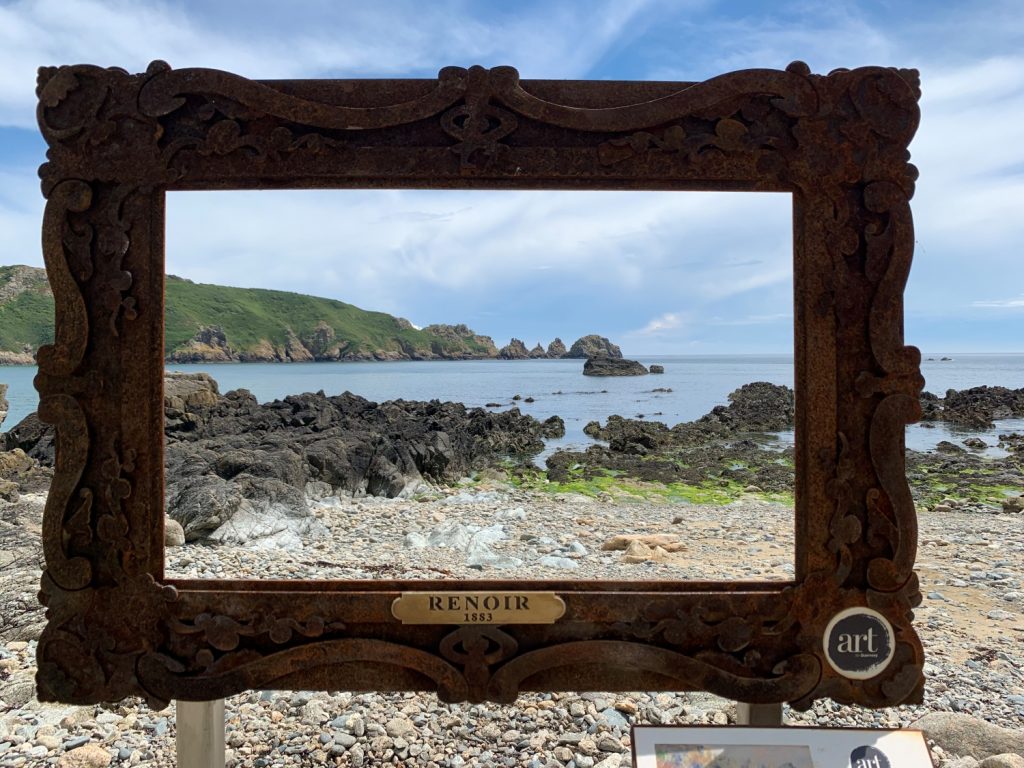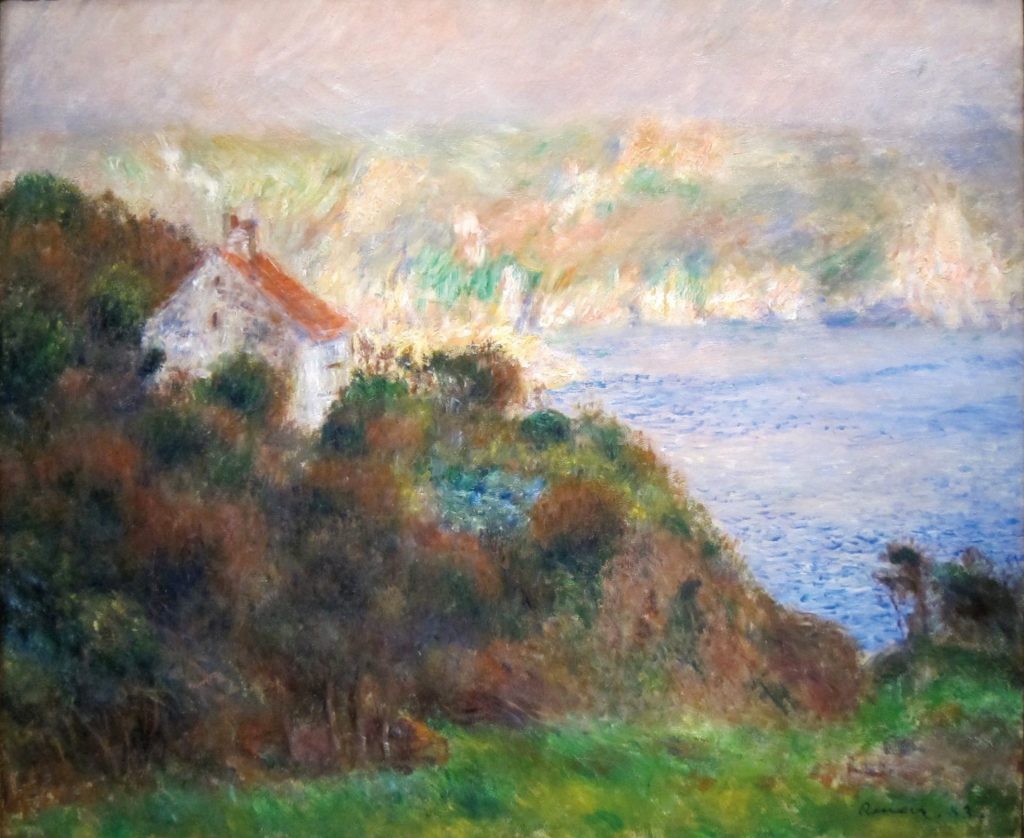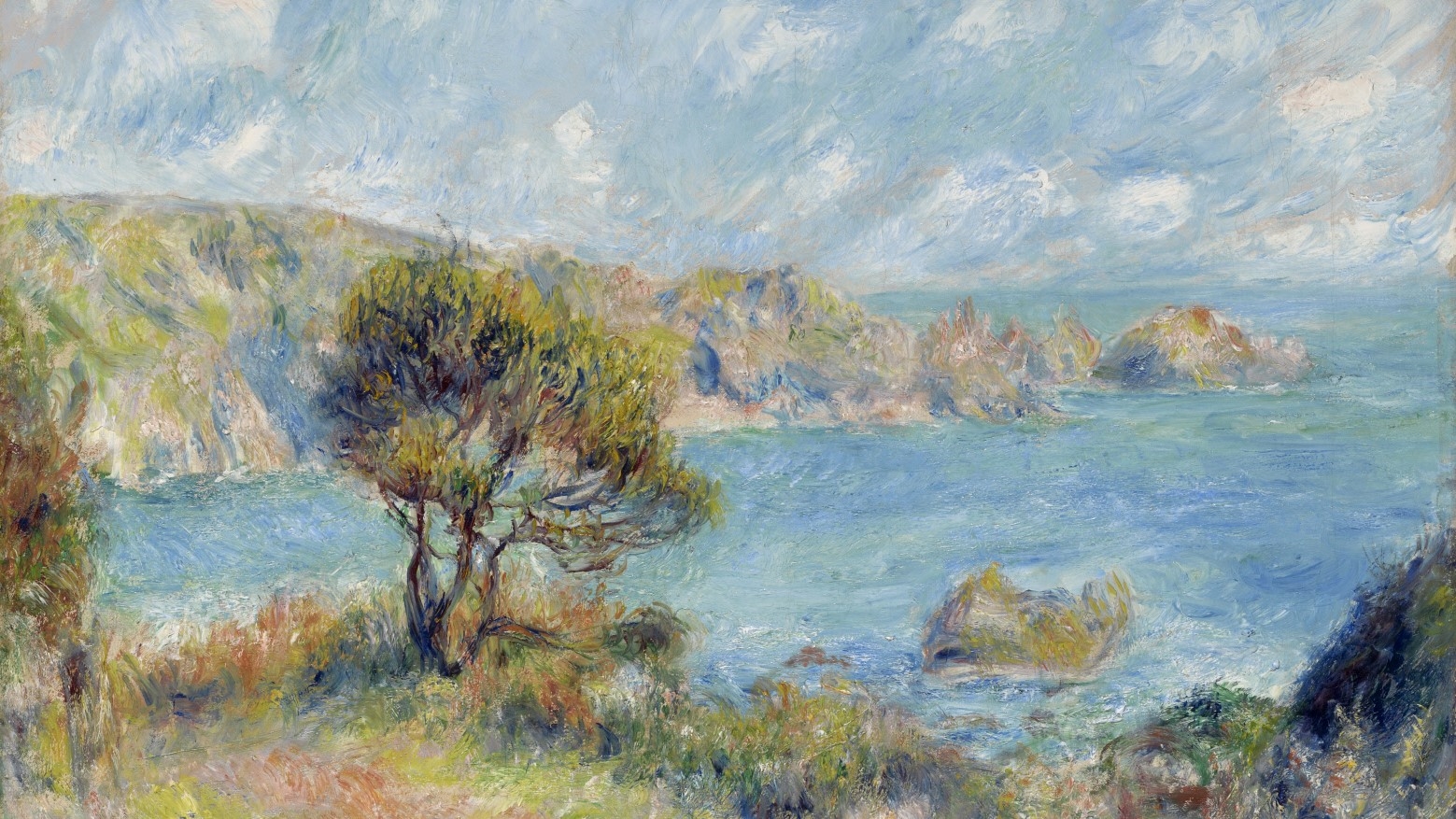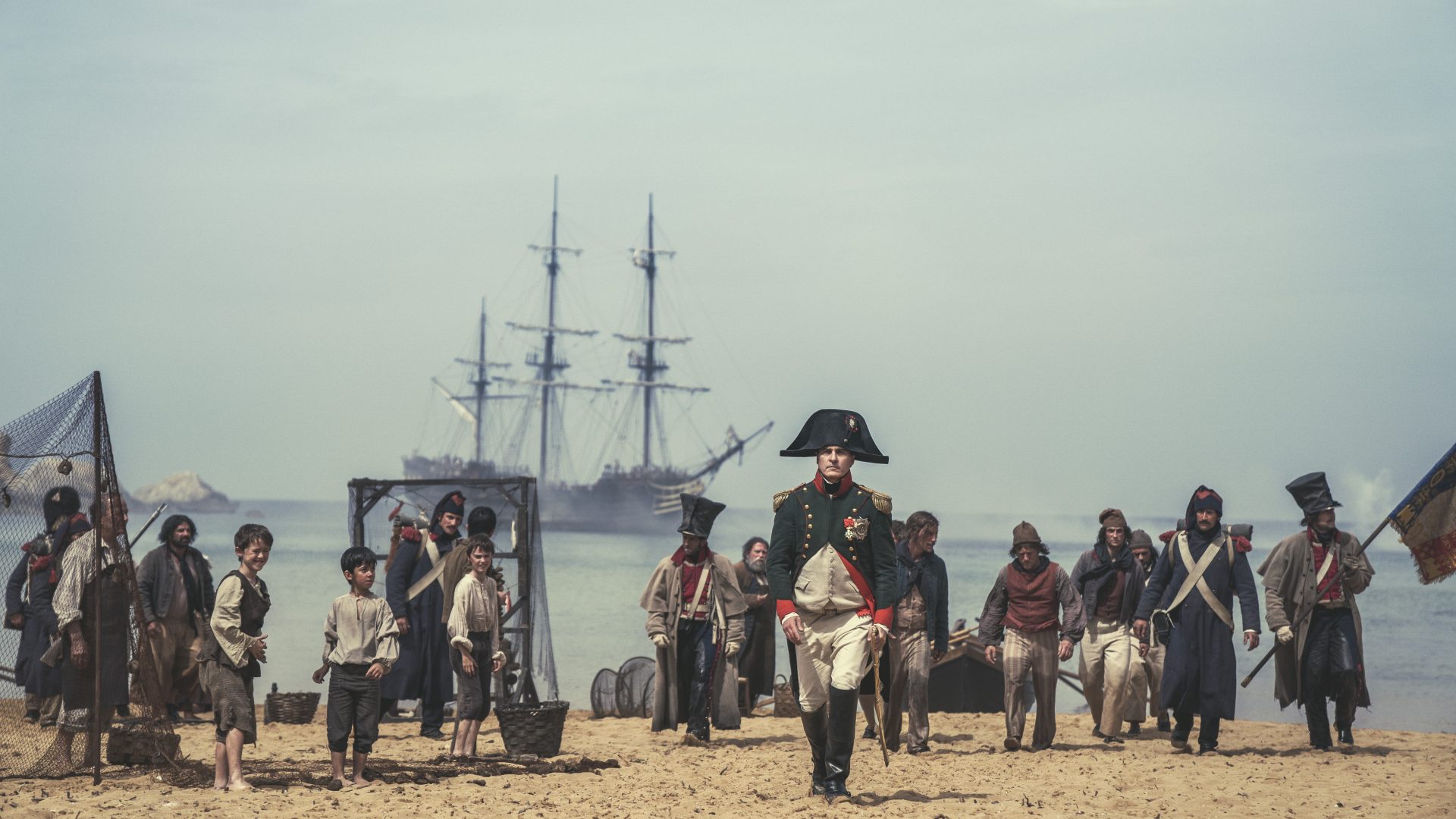After a beautiful August, the forecast for September 1883 was not promising: “Rainfall this month will be above average, and around the 2nd, 17th and 24th one must expect storms.” But the French-born artist Pierre-Auguste Renoir was on his extensive travels, and it would take more than a shower or two to put an end to his five-week stay on Guernsey.
On the island, he was captivated by the free and easy habits of local people. Clearly those storms didn’t amount to much, or deter swimmers. “Here I find myself on a charming beach, quite unlike our Normandy beaches,” he wrote to his dealer, the influential Paul Durand-Ruel. “Here people bathe among the rocks that serve as cabins, since there’s nothing else; nothing is more attractive than this mixture of women and men crowded on these rocks. One would believe oneself in a landscape by Watteau rather than in the real world.”
It was Durand-Ruel’s purchase in 1881 of 49 of Renoir’s pictures – a gratifyingly large sale – that had funded the artist’s ambitious travels throughout the 1880s. First he headed for Algeria, with his friend and fellow painter Paul Lhote, following in the footsteps of Eugène Delacroix. Then, with his lover and model Aline Charigot, he set about a grand tour of Italy, taking in Venice, Padua, Florence and Rome, where he visited the cheerful Palazzo Farnesina with its frescoes by the young Raphael. After Naples and Salerno he popped down to Calabria and back over to the island of Capri.
In Palermo, in the new year, he painted Richard Wagner’s portrait, and moved on to the pretty little port town of L’Estaque, west of Marseille, working alongside Paul Cézanne. A bout of pneumonia prompted a move to Algeria, on doctor’s orders, until he returned to Dieppe, painting his dealer’s children. On and on went the journeys. By the end of 1883 Renoir would be travelling along the Mediterranean coast from Marseille to Genoa with Claude Monet, dropping in on Cézanne on the way. But in the midst of this restless period, the five weeks he spent on Guernsey were pivotal.
It was here that he worked on the challenge of successfully combining the nude with the landscape, knitting the human foreground with the natural background, and these are flesh-and-blood figures, not otherworldly woodland creatures. He was entertained by the relaxed unbuttoning, literally, of the British abroad.
“In Guernsey, I made some paintings of beaches,” he wrote to the art dealer Ambroise Vollard. “All those English Protestants did not feel obliged, when on holiday, to display the prudishness de rigueur in their country.”
Some of the many paintings he made on Guernsey were done straightaway, others were worked upon later in the studio, and still more were given titles that included the word Guernsey, but which show landscapes that don’t exist on that island.
This intense period is the subject of an exhibition on Guernsey that marks 140 years since the painter’s stay, and celebrates the close artistic relationship between the island and France. Detective work and scholarship combined have identified the pieces that he really did paint there, many of which have been loaned to Guernsey Museum and Art Gallery from institutions that include the National Gallery in London, the Musée Marmottan Monet in Paris, and the Ny Carlsberg Glyptotek in Copenhagen.
The London and Copenhagen pictures both experiment with carefree figures raggedly placed into an active sea, whereas Paris’s voluptuous, sculptural Bather Seated on a Rock is in the classical tradition. Monet bought the picture, and Durand-Ruel snapped up four of the Guernsey paintings straightaway.

The temporary return to their place of inspiration of 22 paintings and drawings grew out of a project called Art for Guernsey, founded by David Ummels, who settled on the island eight years ago, with the intention of bringing up his family in a small community but close to mainland Europe. In 2019, fascinated by the Renoir connection, he instigated the Renoir Walk, installing empty gilt frames at points in the landscape where they would put into focus the views that Renoir admired, thus bringing the paintings to life.
Perhaps the greatest achievement of the movement to put Renoir’s Guernsey stay on the map of art history was the purchase by the island itself of Rochers de Guernsey avec personnages (Rocks in Guernsey with Figures, 1883). Similar in style and subject matter to the London and Copenhagen scenes, it shows a dozen or so loosely painted, youthful figures in loose shifts, paddling or swimming between rocky outcrops in the sea which would be alarming but for their jaunty yellow tones. The swimmers put them to good use, clambering on and off the naturally occurring bathing platforms to take a break from the waves.
The painting was one of five works painted on Guernsey and still in private hands when it went up for sale at Christie’s in London. A consortium of island-based collectors beat off stiff competition to acquire Rochers de Guernsey avec personnages, at Christie’s for a felicitous £443,000. The consortium knew that a major private collector had expressed a keen interest in the piece, but the fierce bidding war that was expected mysteriously did not materialise. “His loss was our gain,” recalls Ummels. “We managed to purchase the artwork, not only significantly under our own budget, but also under the auction house’s estimate.”
Once the picture was returned to Guernsey, schoolchildren were invited to view and respond to the work, and it was this engagement with young people that persuaded the sought-after art expert Cyrille Sciama, now curator of the Musée des Impressionismes in Monet’s house at Giverny, to visit Guernsey. He curates the current exhibition.

Renoir’s route to Guernsey began with his apprenticeship at the age of 13 to the porcelain painters Lévy Frères & Compagnie in 1854, when his father Léonard, a tailor, and mother Marguerite, a seamstress, moved from his birthplace, Limoges, to Paris. They could not afford to educate him beyond the age of 13, but he was able to attend free classes offered by the drawing and decorative arts school run by sculptor Louis-Denis Caillouette.
His progress must have been exceptional, because at 18 he was listed among students authorised to work in the Louvre, and just after his 21st birthday he was admitted to the prestigious and highly selective École des Beaux-Arts.
He was born into a golden age of French painting, numbering among his friends and contemporaries Claude Monet, Gustave Courbet, and Alfred Sisley. A portrait of Sisley’s father, William, was one of two paintings exhibited in Paris at the fastidious Salon in 1865. When the Salon rejected Renoir’s submissions in 1867 he was in good company: Monet, Cézanne and Manet were similarly turned down.
In 1869 he worked side by side with Monet, notably at the bathing pools of La Grenouillière on the Seine. Here the two worked, almost indistinguishable from each other, on compositions of figures in watery landscapes, prefiguring the Guernsey scenes.
Renoir’s first sale to Durand-Ruel was in 1872, and two years later he showed seven works in the landmark First Impressionist Exhibition in Paris. There were 18 Renoirs in the second, 21 in the third, before the artist began to fall away from the movement and skip the rest. Then he hit the jackpot with his big sale to Durand-Ruel.
After his September and October weeks in Guernsey, the artist was on the move again, travelling with Monet, visiting Cézanne. The birth of the first of three sons in 1885 and marriage to Aline in 1890 curtailed the new father’s wanderlust a little, but family holidays continued to favour French beauty spots, and successful exhibitions came thick and fast.
Arthritis was taking its toll when his first picture was bought for a French national collection in 1892. Then the death of Gustave Caillebotte, for whom Renoir was executor, meant a windfall for the French state. The artist left his personal art collection to the state, of which 38 works were accepted, eight of them Renoirs, now in Paris’s Musée d’Orsay.
Aline died of a heart attack in Nice in 1915, near the couple’s adopted home of Cagnes-sur-Mer, where they had lived since buying a comfortable estate in 1907. When Renoir died in 1919 at the age of 77, five Guernsey canvases were discovered in his studio, withheld from the open market. Among them were the bathers in the rocks that the island now owns.
That painting was key to Renoir’s artistic legacy, Ummels believes: “The narrative of the nudes in landscapes (especially the bathers in landscapes), which Renoir found the inspiration in Guernsey in 1883, accompanied him for the next few decades and undoubtedly contributed to his global fame. Only three years later, Renoir’s agent, Durand-Ruel, introduced Impressionism to America, with a ground-breaking exhibition in New York, and from that moment on, very few European collectors could afford a Renoir.
“All the other nudes in landscapes were purchased by American collectors and are still in the collection of the Barnes Foundation in Philadelphia, the Metropolitan Museum of Art in New York, and others. It could be that Renoir wanted to keep some of the early examples of ‘nudes in landscapes’ close to him – and to his heart.”
Renoir in Guernsey, 1883, is at Guernsey Museum at Candie, until December 17.




